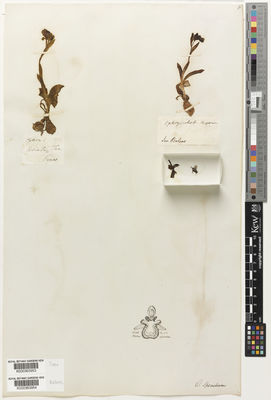Geography and distribution
Ophrys speculum is widespread in the Mediterranean, from Portugal and Spain in the west to Turkey and Lebanon in the east and also in North Africa. However, it is absent from Cyprus and much of Italy, and is rare in France and Crete. It occurs up to 1,200 m above sea level.
Description
Overview: A terrestrial orchid up to 25 cm tall.
Leaves: Rosette of leaves at the base of the inflorescence. Up to three sheathing leaves clasp the flowering stem.
Flowers: Each flowering stem bears 3-6 flowers (rarely up to 15). Sepals are up to 1 cm long, pale green and marked with reddish stripes. The much smaller petals are about 5 mm long, dark brown and bent backwards. The lip is three-lobed, 11-16 mm long, largely glossy mid-blue edged with yellow, and fringed with long, shaggy, red-brown hairs.
Mirror orchid usually flowers in March - April. It dies down during the summer and while dormant is present as an underground tuber. A new leaf rosette is formed in the autumn, and photosynthesis takes place during the winter months. As the flower stem emerges in the spring, the leaves begin to die.
Threats and conservation
Ophrys speculum is listed on Appendix II of CITES (Annex B within the European Union), which means that international trade is only allowed by special permit. Along with nearly all other orchids with distinct underground tubers, collection for salep production is the main threat.
Uses
The distinct underground tubers of many orchids, including Ophrys speculum , are collected for salep production in some eastern Mediterranean countries. Tubers are dried and ground to produce flour (salep), which is used to make desserts and drinks.
Millennium Seed Bank: Seed storage
The Millennium Seed Bank Partnership aims to save plant life worldwide, focusing on plants under threat and those of most use in the future. Seeds are dried, packaged and stored at a sub-zero temperature in our seed bank vault.
A collection of Ophrys speculum seeds is held in Kew's Millennium Seed Bank based at Wakehurst in West Sussex.
Cultivation
At Kew, mirror orchid is grown in an open polytunnel under indirect light. It is potted in a loam-based mix, to which Seramis (clay granules) and fine bark are added.
It is watered as needed to keep the compost damp when in growth, with watering reduced as the leaves and stem die back in the summer. It is kept dry during summer dormancy.
It is propagated using micropropagation (growing plants in a laboratory from seed or small pieces of tissue under sterile conditions, on specially selected media) but subsequent weaning (exposing plantlets to environmental conditions closer to those of their natural environment) is difficult. Ophrys speculum rarely multiplies vegetatively.
This species at Kew
Mirror orchid is grown in the behind-the-scenes Tropical Nursery at Kew.
Dried and alcohol-preserved specimens of Ophrys speculum are held in Kew's Herbarium, where they are available to researchers from around the world by appointment. The details of some of these can be seen online in Kew's Herbarium Catalogue.
Molecular research and bee orchids at Kew
The number of species of bee orchids ( Ophrys species) that exist in Europe has been much-debated and was the subject of a recent project funded by the John S. Lewis Foundation, involving Kew scientists Dion Devey and Mike Fay, working alongside partners Richard Bateman (an independent scientist working mostly at Kew) and Julie Hawkins (Reading University).
The team used a wide range of molecular and morphological techniques in their field study of bee orchid populations across the Mediterranean region. They could discriminate only ten species of Ophrys , even when they applied all the available diagnostic markers, and even then only six groups proved to be consistently recognisable. Morphological analyses also showed significant overlap between populations that had previously been assigned to different species. The results of these studies will help scientists to more effectively prioritise populations for conservation.



